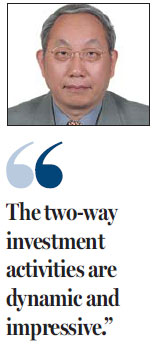Bilateral business ties add benefits to both countries
Australian Prime Minister Malcolm Turnbull's visit to China this month is of great importance to the bilateral relationship.
On behalf of the Chinese embassy in Australia, I would like to extend my warm congratulations to all the sponsors and participants on the holding of 2016 Australian Week in China from April 11 to 15.
The event has brought hundreds of Australian business leaders and entrepreneurs to major Chinese cities for talks on trade deals, investment projects and other cooperation.
The China-Australia Free Trade Agreement has opened a new era for our bilateral commercial ties, and the current session of the event could serve as a key platform to tap and realize such valuable potential.
For years, China has been proud to be Australia's top trading partner.

We have been working closely with all Australian stakeholders to further strengthen this cornerstone of our strategic partnership to the benefit of both sides.
Last year witnessed major breakthroughs in the Sino-Australia economic relationship: we signed the ChAFTA and put it into force, which means a better business environment and fewer barriers for exporters, importers, investors and service providers.
We also concluded a bilateral sanitary protocol for exports of live beef cattle from Australia to China, a very popular move from the perspective of Chinese consumers.
Last year, our bilateral trade in goods stood at AUD$142.84 billion ($109.6 billion), for which Australia enjoyed a trade surplus of A$19.48 billion.
The two-way investment activities are dynamic and impressive.
The estimated value of capital flow between the two countries was around $10 billion for 2015.
According to Chinese sources, the stock of cumulative Chinese investment in Australia is over $75 billion. New deals of mergers and acquisitions or investment cover a broad range of sectors and products, such as oil and gas, electric power, renewable energy, food and beverage, agriculture, aquaculture, mining, banking, securities, construction, housing, healthcare, hospitalities and logistics.
These important cooperation projects will make positive contributions to the development of local or regional economies by creating jobs, tax revenues and new facilities or capacities to meet the growing demand of various consumers.
Last year, Australia joined the Asian Infrastructure Investment Bank as a founding member, and our cooperation in this sector has entered a golden age.
We are now working together to build or run ports, urban light rail systems, roads, railways, power grids, aviation facilities and gas pipelines in Australia.
We also work together to improve the tourist infrastructure by opening more flights between Australian and Chinese cities, by building more hotels, restaurants, holiday resorts, serviced apartments, and by simplifying the visa application process.
As a result, over one million Chinese visited Australia last year, contributing significantly to the surplus of trade in services.
The Chinese economy is in the process of restructuring and transformation for better quality and higher efficiency.
In 2015, the Chinese economy grew by 6.9 percent and remained a key driving force for global growth. China is still number one in the world for trade in goods and exports.
It has been the biggest recipient of foreign investment among developing countries. At the same time China has become a major overseas investor, with an outward investment of over $100 billion last year. Australia is already one of the most-favored destinations for Chinese investment.
Under the Belt and Road Initiative for international partnership and sustainable development, Chinese and Australian firms can collaborate further to explore new business opportunities.
This year marks the first year of China's 13th Five-Year Plan (2016-21), a critical year for our economy to evolve into a new normal of medium-to-high speed growth.
China will uphold the concepts of innovation, coordinated and green development, opening up and inclusiveness.
China is committed to deepening reforms and opening its door wider for more international exchange and cooperation. Efforts will intensify for supply-side reforms to stress the role of market forces for sustainable development. This implies more emphasis on enhancing global collaboration in manufacturing capacities.
The author is minister counselor for Economic and Commercial Affairs of the Chinese Embassy in Australia.
(China Daily 04/15/2016 page19)














